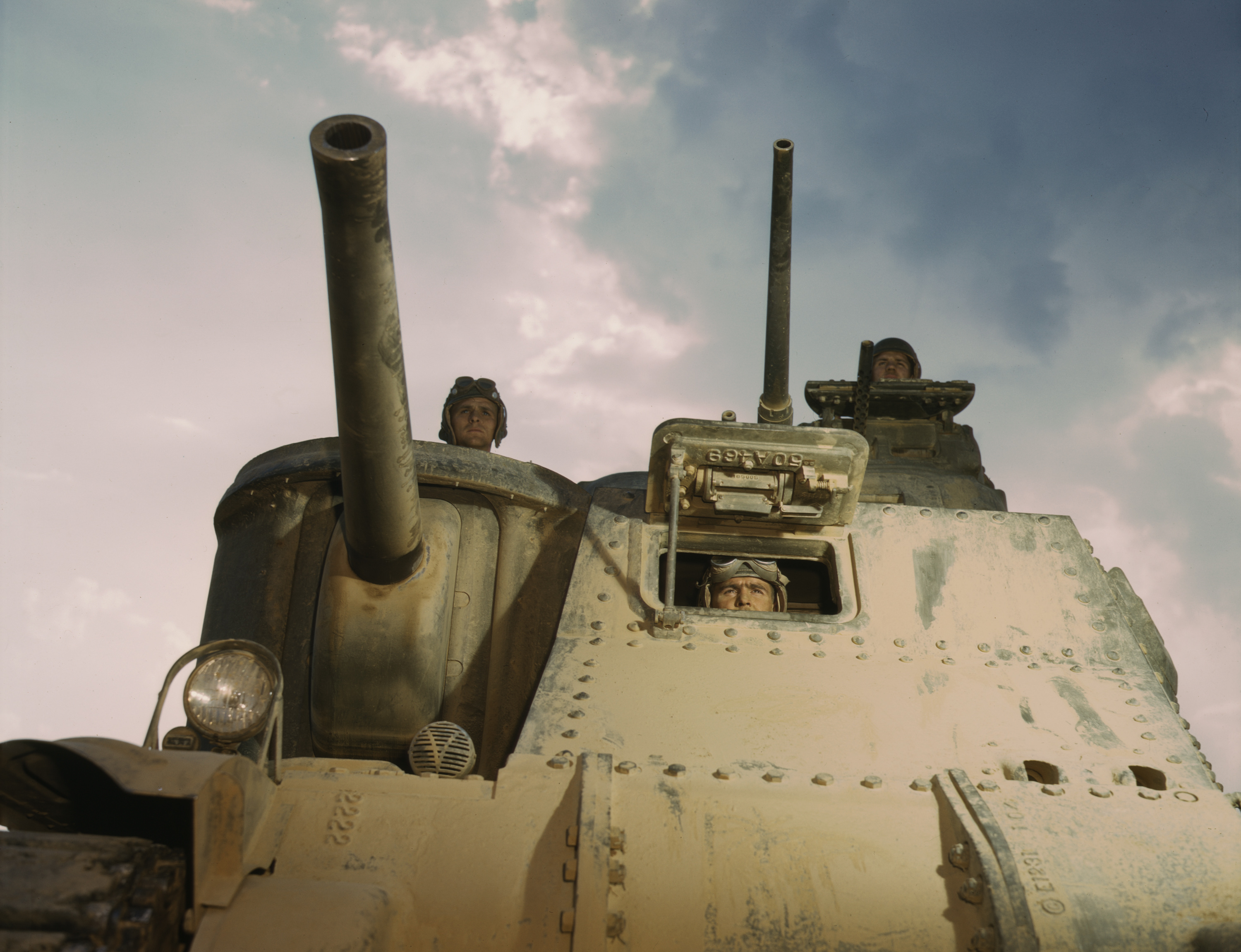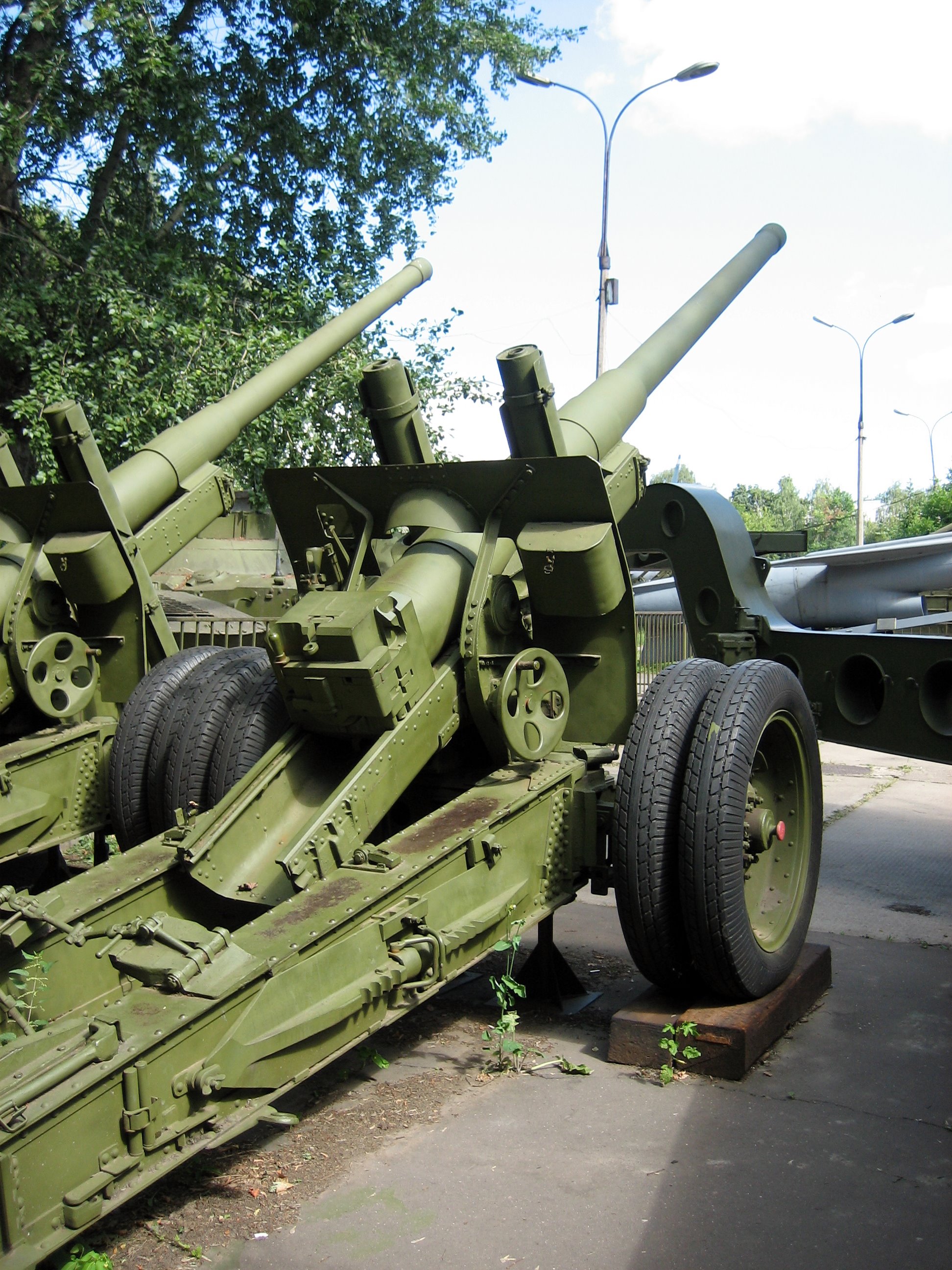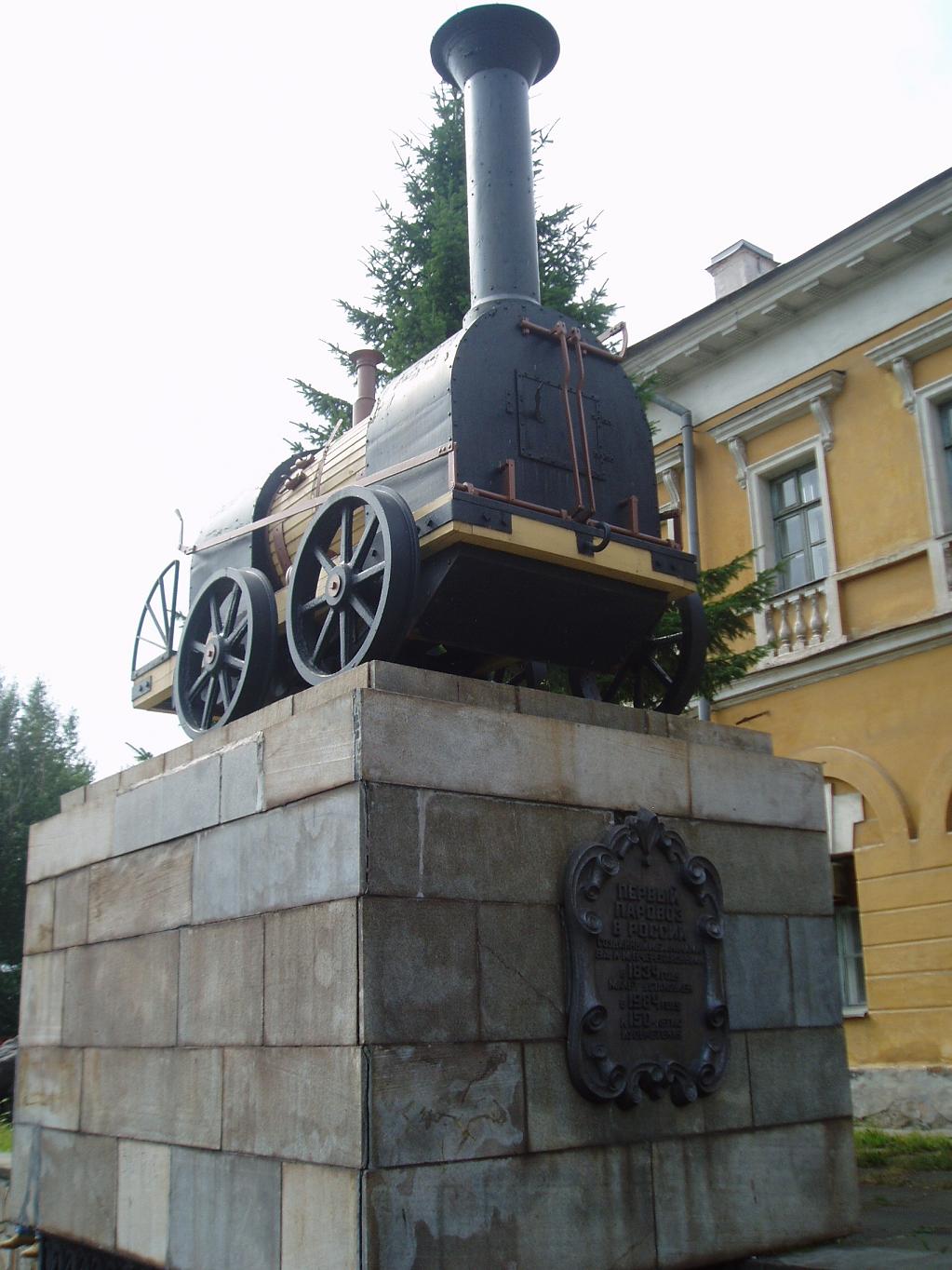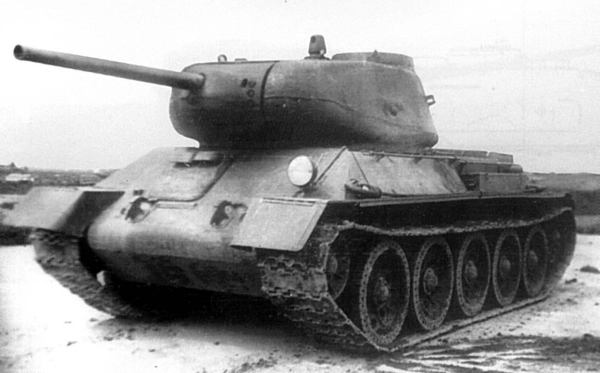|
T-44 Tank
The T-44 was a medium tank developed and produced near the end of World War II by the Soviet Union. It was the successor to the T-34, offering an improved ride and cross-country performance, along with much greater armor. Designed to be equipped with an 85 mm main gun, by the time it was fully tested the T-34 had also moved to this weapon. Both tanks offered similar performance, so introducing the T-44 was not considered as important as increasing T-34 production. Fewer than 2,000 T-44s were built, compared to about 58,000 T-34s. Although the T-44 was available by the end of the war, it was not used in any battle. It was 1 ton lighter than the T-34-85 and slightly faster. The T-44 was heavily influential on the design of the T-55, T-54/55 Medium tank, most prominently lower hull and turret profiles. Also notable was the T-44-100, a 100mm D-10 tank gun, D-10T-armed prototype, which would be the same 100mm gun mounted on the T-54/55, bar some minor changes. Attempts were made ... [...More Info...] [...Related Items...] OR: [Wikipedia] [Google] [Baidu] |
Soviet Union
The Union of Soviet Socialist Republics. (USSR), commonly known as the Soviet Union, was a List of former transcontinental countries#Since 1700, transcontinental country that spanned much of Eurasia from 1922 until Dissolution of the Soviet Union, it dissolved in 1991. During its existence, it was the list of countries and dependencies by area, largest country by area, extending across Time in Russia, eleven time zones and sharing Geography of the Soviet Union#Borders and neighbors, borders with twelve countries, and the List of countries and dependencies by population, third-most populous country. An overall successor to the Russian Empire, it was nominally organized as a federal union of Republics of the Soviet Union, national republics, the largest and most populous of which was the Russian SFSR. In practice, Government of the Soviet Union, its government and Economy of the Soviet Union, economy were Soviet-type economic planning, highly centralized. As a one-party state go ... [...More Info...] [...Related Items...] OR: [Wikipedia] [Google] [Baidu] |
Glacis
A glacis (, ) in military engineering is an artificial slope as part of a medieval castle or in early modern fortresses. They may be constructed of earth as a temporary structure or of stone in more permanent structure. More generally, a glacis is any slope, natural or artificial, which fulfils the above requirements. The etymology of this French word suggests a slope made dangerous with ice, hence the relationship with ''glacier''. A ''glacis plate'' is the sloped front-most section of the hull of a tank or other armoured fighting vehicle. Ancient fortifications A glacis could also appear in ancient fortresses, such as the one the ancient Egyptians built at Semna in Nubia. Here it was used by them to prevent enemy siege engines from weakening defensive walls. Hillforts in Britain started to incorporate glacis around 350 BC. Those at Maiden Castle, Dorset were high. Medieval fortifications Glacises, also called taluses, were incorporated into medieval fortifications ... [...More Info...] [...Related Items...] OR: [Wikipedia] [Google] [Baidu] |
Sponsons
Sponsons are projections extending from the sides of land vehicles, aircraft or watercraft to provide protection, stability, storage locations, mounting points for weapons or other devices, or equipment housing. Watercraft On watercraft, a sponson is a projection that extends outward (usually from the hull, but sometimes other parts of the vessel) to improve stability while floating, or to act as a securing point for other equipment. Vessels with unstable body shapes or unevenly distributed weight are likely to feature sponsons to help prevent capsizing or other instabilities. On many vessels, these projections from the main body of the vessel can be attached and removed quickly and fairly easily. Canoes and kayaks sometimes feature sponson attachments as well, for stability in rough waters. These differ from outriggers, which extend a significant distance away from the body of the craft, and are employed on craft designed for open waters. A sponson's terminus is close to the cra ... [...More Info...] [...Related Items...] OR: [Wikipedia] [Google] [Baidu] |
D-25 Gun
122 mm corps gun M1931/37 (A-19) () was a Soviet Union, Soviet field gun developed in late 1930s by combining the barrel of the 122 mm gun M1931 (A-19) and the carriage of the 152 mm howitzer-gun M1937 (ML-20). The gun was in production from 1939 until 1946. It saw action in World War II (primarily with corps and RVGK artillery of the Red Army) and remained in service for a long time after the end of the war. Vehicle-mounted variants of the gun were fitted to the IS-2 and IS-3 (tank), IS-3 tanks of the Iosif Stalin tank, Iosif Stalin series of tanks and the ISU-122 self-propelled gun. Development history In 1936 the Red Army adopted the 122 mm gun M1931, also known as A-19. Unlike earlier ordnance pieces used by the Red Army, it had Gun carriage#Modern gun carriages, split trail carriage with suspension, and consequently improved mobility and traverse. The carriage of M1931 had a number of shortcomings though. The elevation mechanism was slow and unreliable; solid-tired ... [...More Info...] [...Related Items...] OR: [Wikipedia] [Google] [Baidu] |
Vehicle Armour
Military vehicles are commonly armoured (or armored; American and British English spelling differences#-our, -or, see spelling differences) to withstand the impact of Fragmentation (weaponry), shrapnel, bullets, Shell (projectile), shells, Rocket (weapon), rockets, and missiles, protecting the personnel inside from enemy fire. Such vehicles include armoured fighting vehicles like tanks, aircraft, and ships. Civilian vehicles may also be armoured. These vehicles include cars used by officials (e.g., Official state car, presidential limousines), reporters and others in conflict zones or where violent crime is common. Civilian Armored car (valuables), armoured cars are also routinely used by security firms to carry money or valuables to reduce the risk of highway robbery or the Carjacking, hijacking of the cargo. Armour may also be used in vehicles to protect from threats other than a deliberate attack. Some spacecraft are equipped with specialised armour to protect them against im ... [...More Info...] [...Related Items...] OR: [Wikipedia] [Google] [Baidu] |
Joseph Stalin
Joseph Vissarionovich Stalin (born Dzhugashvili; 5 March 1953) was a Soviet politician and revolutionary who led the Soviet Union from 1924 until Death and state funeral of Joseph Stalin, his death in 1953. He held power as General Secretary of the Communist Party of the Soviet Union, General Secretary of the Communist Party from 1922 to 1952 and as the fourth Premier of the Soviet Union, premier from 1941 until his death. He initially governed as part of a Collective leadership in the Soviet Union, collective leadership, but Joseph Stalin's rise to power, consolidated power to become an absolute dictator by the 1930s. Stalin codified the party's official interpretation of Marxism as Marxism–Leninism, while the totalitarian political system he created is known as Stalinism. Born into a poor Georgian family in Gori, Georgia, Gori, Russian Empire, Stalin attended the Tiflis Theological Seminary before joining the Marxist Russian Social Democratic Labour Party. He raised f ... [...More Info...] [...Related Items...] OR: [Wikipedia] [Google] [Baidu] |
Operation Barbarossa
Operation Barbarossa was the invasion of the Soviet Union by Nazi Germany and several of its European Axis allies starting on Sunday, 22 June 1941, during World War II. More than 3.8 million Axis troops invaded the western Soviet Union along a front, with the main goal of capturing territory up to a line between Arkhangelsk and Astrakhan, known as the A-A line. The attack became the largest and costliest military offensive in history, with around 10 million combatants taking part in the opening phase and over 8 million casualties by the end of the operation on 5 December 1941. It marked a major escalation of World War II, opened the Eastern Front—the largest and deadliest land war in history—and brought the Soviet Union into the Allied powers. The operation, code-named after the Holy Roman Emperor Frederick Barbarossa ("red beard"), put into action Nazi Germany's ideological goals of eradicating communism and conquering the western Soviet Union to repopulate it w ... [...More Info...] [...Related Items...] OR: [Wikipedia] [Google] [Baidu] |
Nizhny Tagil
Nizhny Tagil ( rus, Нижний Тагил, p=ˈnʲiʐnʲɪj tɐˈgʲil) is a classification of inhabited localities in Russia, city in Sverdlovsk Oblast, Russia, located east of the Boundaries between the continents#Asia and Europe, boundary between Asia and Europe. Demographics History The history of Nizhny Tagil dates back to the mid-16th century, when the Stroganovs received the right to possess land by the Kama (river), Kama and Chusovaya basins. In 1579 they founded the first settlement, the Utkin sloboda (settlement), sloboda, by the river Utka, the mouth of Chusoya. Fateyevo, the first Russian village in the Tagil region, was founded in 1665. In 1696, by the order of Tsar Peter the Great, the Vysokogorsky iron ore quarry was opened. Voevode Dmitry Protasyev was elected to search for iron and magnetic ores. The deposits were particularly rich, and included lodes of pure magnetic iron. The surrounding landscape provided everything needed for a successful and product ... [...More Info...] [...Related Items...] OR: [Wikipedia] [Google] [Baidu] |
T-34 Variants
The T-34 medium tank is one of the most-produced and longest-lived tanks of all time. Identification of T-34 variants can be complicated. Turret castings, superficial details, and equipment differed between factories; new features were added in the middle of production runs, or retrofitted to older tanks; damaged tanks were rebuilt, sometimes with the addition of newer-model equipment and even new turrets. Some tanks had appliqué armor made of scrap steel of varying thickness welded onto the hull and turret; these tanks are called ''s ekranami'' ("with screens"), although this was never an official designation for any T-34 variant. Model naming Since the break-up of the Soviet Union, newly declassified sources have demonstrated that all T-34s with the original turret and F-34 gun (conventionally known as Models 1941 and 1942) were officially called "Model 1941", and hexagonal-turret T-34 (Model 1943) was officially called "Model 1942". German military intelligence, intell ... [...More Info...] [...Related Items...] OR: [Wikipedia] [Google] [Baidu] |
D-5T
The 85 mm air defense gun M1939 (52-K) () was an Soviet anti-aircraft gun, developed under guidance of leading Soviet designers M. N. Loginov and G. D. Dorokhin. This gun was successfully used throughout the Second World War against level bombers and other high- and medium-altitude targets. In emergencies they were utilized as powerful anti-tank weapons. The barrel of the 52-K was the basis for the family of 85-mm Soviet tank guns. After the war some 52-Ks were refitted for peaceful purposes as anti-avalanche guns in mountainous terrain. Virtually every country behind the Iron Curtain received this gun after World War II for their air defense. In the Soviet Union itself, these guns were largely superseded by the 100 and 130 mm guns. Description Adopted in 1939, the 85-mm M1939, like its German counterpart the 88-mm Flak 18/36/37, was meant for air defense. Like many anti-aircraft (AA) guns of the era it was also provided with anti-tank ammunition in the event a tank sh ... [...More Info...] [...Related Items...] OR: [Wikipedia] [Google] [Baidu] |
T-43 Medium Tank
The T-43 medium tank was a prototype Soviet medium tank developed during the Second World War as a possible replacement for both the T-34 medium and KV-1 heavy tanks. The project's aim was to build a medium tank with heavier armour, but German advances in tank technology proved better countered by a more heavily armed T-34-85 and the T-43 was cancelled. History The T-34 medium tank was the mainstay of Soviet mechanized forces in World War II, produced in huge numbers. In May 1942, Soviet forces started encountering German tanks armed with the new long 75mm KwK 40 gun which could easily penetrate a T-34 at long range. In June 1942, the Soviet Main Directorate of Armoured Forces (GABTU) issued a requirement to two tank-design bureaus to compete in designing a "universal tank", which would combine the heavy armour of heavy tanks with the mobility of the T-34 medium tank. The SKB-2 heavy tank design bureau in Chelyabinsk started the KV-13 program, which two years later resulted ... [...More Info...] [...Related Items...] OR: [Wikipedia] [Google] [Baidu] |








